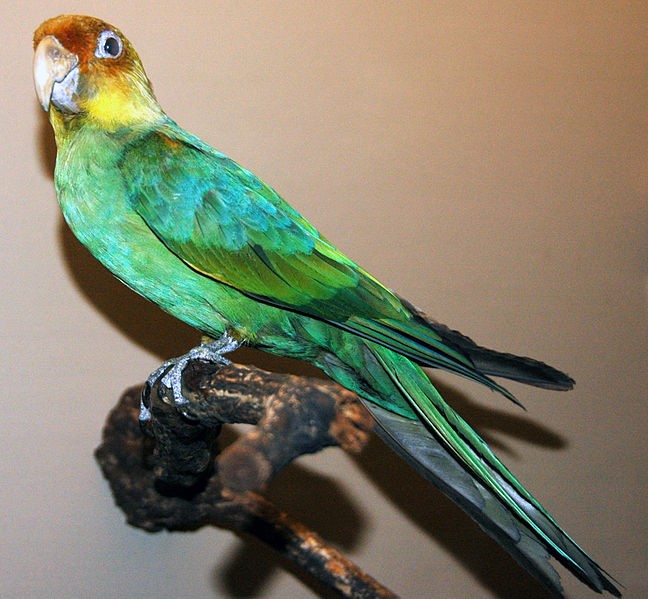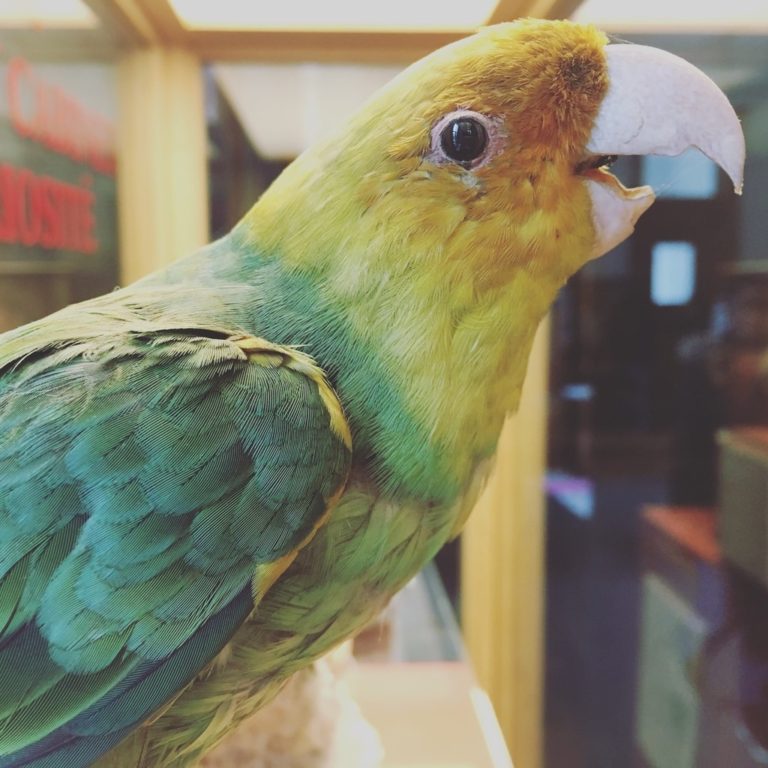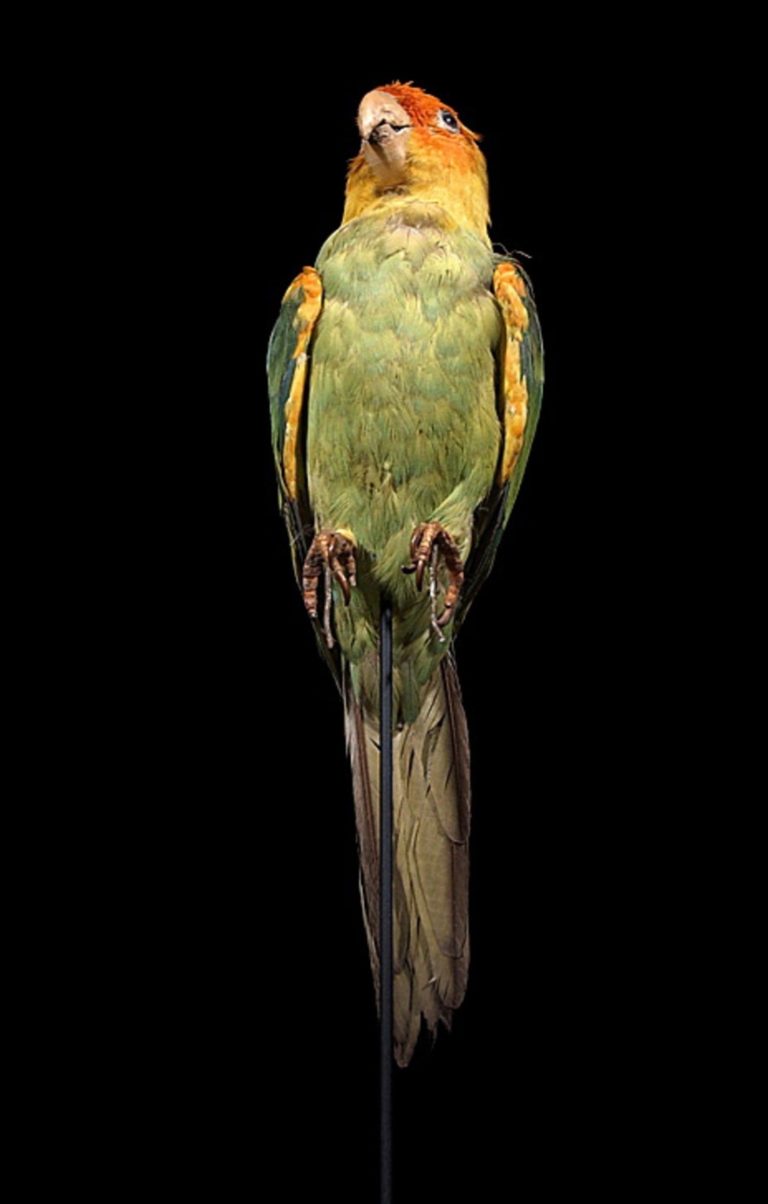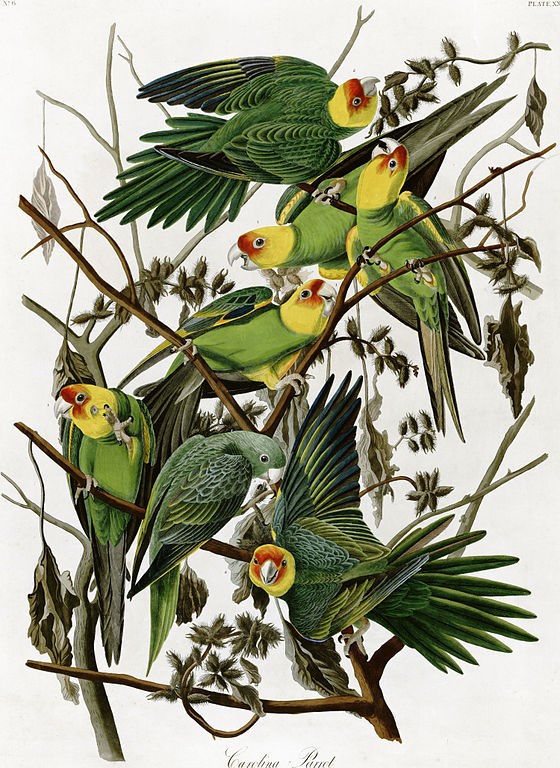Birdfinding.info ⇒ The last universally accepted record of wild Carolina Parakeets was Frank Chapman’s collection of four specimens at Taylor Creek, north of Lake Okeechobee, Florida, in April 1904. The last known captive individual died in the Cincinnati Zoo on February 21, 1918. It seems likely that the species persisted far beyond those dates, however, as apparently credible reports of wild flocks in swamplands from southern North Carolina to south-central Florida continued until the late 1930s and early ‘40s. Most reports were along Florida’s interior waterways, especially in the St. John’s River area. Other intriguing reports detailed by Snyder (2004) include 30 seconds of now-lost color film footage reportedly shot in the Okefenokee Swamp of Georgia, undated (but sometime after that type of film became available in 1936), which showed a small flock of blurry, apparently yellow-headed parakeets feeding, and numerous sightings in the ‘30s along the lower Santee River in South Carolina, with the latest persuasively attested sighting near Council, North Carolina, in the spring of 1944.
Carolina Parakeet †
Conuropsis carolinensis
Extinct. Formerly inhabited the eastern U.S.
When European settlement of North America began, the Carolina Parakeet was widely distributed in bottomland forests and swamps of the Carolinian region, west to eastern Colorado and central Texas, and north to southeastern South Dakota, southern Wisconsin, and the southern shores of the Great Lakes.

Approximate historical distribution of the Carolina Parakeet by subspecies, with red line indicating a previously accepted approximation. © Burgio et al. 2017
The two recognized subspecies apparently inhabited somewhat distinct biomes, one in interior river basins and the other in swamplands of the coastal plain. The nominate carolinensis occurred essentially throughout Florida and adjacent parts of southern Alabama and Georgia, and in narrow coastal strips north to eastern North Carolina and west to around Baton Rouge, Louisiana. In the interior, ludovicianus occupied much of the Mississippi Valley and its tributary drainages, with outlying populations in New York, Pennsylvania, Maryland, Virginia, and south-central Alabama and Georgia—where it may have overlapped with carolinensis.
The only parakeet native to the northern temperate zone was persecuted as an agricultural pest and captured in large numbers to be held in captivity. A highly sociable and confiding temperament apparently rendered it vulnerable to mass slaughter and capture.
It had evolved a tolerance to the toxins in the seeds of cockleburs, which provided it with a food source that was available year-round throughout its range. Heavy reliance on cockleburs was evidently an important reason why it was able to survive as a resident species in areas with cold, snowy winters, and the toxins may have rendered it unpalatable to predators. A lack of predators favors fearlessness, which would help explain its vulnerability to the novel depredations of Europeans.
Across most of its range, it disappeared along with the westward expansion of European settlement. Although not necessarily reliable indicators of its true dates of local extirpation, the years when it was last reported in several states were: Indiana, 1851; Ohio, 1856; Kentucky, 1878; Missouri, 1905; Louisiana, 1910; and Kansas, 1912.
Identification
The adult was green with a yellow hood, reddish-orange forecrown and face, and a large pale bill.

Carolina Parakeet. © Naturalis Biodiversity Center

Carolina Parakeet, mounted specimen on display in the Field Museum of Natural History, Chicago. © James St. John
The leading edge of the wing had a strip of yellow and orange, and the spread wing showed a yellow band across the bases of the primaries.
The juvenile plumage was nearly all-green, with some reddish-orange coloration on the forecrown and face.
Notes
Polytypic species consisting of two recognized subspecies, both extinct: carolinensis and ludovicianus.
IUCN Red List Status: Extinct.
More Images of the Carolina Parakeet

Carolina Parakeet. © jennykendler

Carolina Parakeet, lateral view. © Naturalis Biodiversity Center

Carolina Parakeet, dorsal view. © Naturalis Biodiversity Center

Carolina Parakeet, ventral view showing yellow and orange on the leading edge of the wings. © Naturalis Biodiversity Center
References
BirdLife International. 2021. Conuropsis carolinensis. The IUCN Red List of Threatened Species 2021: e.T22685776A195444267. https://dx.doi.org/10.2305/IUCN.UK.2021-3.RLTS.T22685776A195444267.en. (Accessed January 17, 2022.)
Burgio, K.R., C.J. Carlson, and M.W. Tingley. 2017. Lazarus ecology: Recovering the distribution and migratory patterns of the extinct Carolina parakeet. Ecology and Evolution 7:5467–5475.
Gelabert, P., M. Sandoval-Velasco, A. Serres, M. de Manuel, P. Renom, A. Margaryan, J. Stiller, T. de-Dios, Q. Fang, S. Feng, S. Mañosa, G. Pacheco, M. Ferrando-Bernal, G. Shi, F. Hao, X. Chen, B. Petersen, R.-A. Olsen, A. Navarro, Y. Deng, L. Dalén, T. Marquès-Bonet, G. Zhang, A. Antunes, M.T.P. Gilbert, and C. Lalueza-Fox. 2020. Evolutionary History, Genomic Adaptation to Toxic Diet, and Extinction of the Carolina Parakeet. Current Biology 30:108-114.
Hume, J.P. 2017. Extinct Birds (Second Edition). Bloomsbury Publishing PLC, London.
Snyder, N.F.R. 2004. The Carolina Parakeet: Glimpses of a Vanished Bird. Princeton University Press.
